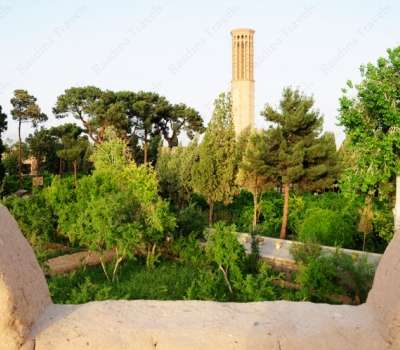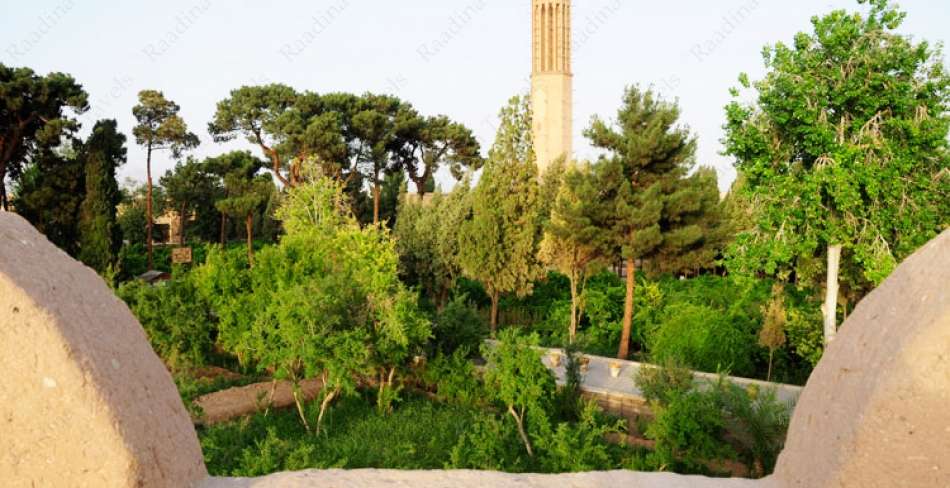

Yazd , A City of History
In the city of Yazd, you can feel the hot weather in any corner, and the smell of history spread throughout its entire space. So that, with the first step and the first glance at this magnificent city, you can feel and understand that it belongs to one thousand years ago. The antiquity of the city caused to be registered as a world heritage site in UNESCO. The construction of Yazd dates back to Sassanid era contemporary to Yazdegerd I. He ordered the construction of a town named Yazesh , which later became known as Yazd.
In some literatures, the initial construction of some towns in Yazd Province is attributed to very earlier time, for example Abarkuh to Abraham the Prophet, Meybod to Solomon the prophet and Yazd to Zahak or Alexander the Great which along with the scattered ancient heritage, expresses the ancient history of culture and history of the land and its people.
Also, the inscription carved on the rocks in Ernan Mountain, pieces of pottery crockeries found in Narin Castle in Meybod belonging to the Elamite period, the rocky hand-tools of Shirkuh Valleys, ancient architectural and urban heritage, the various caves in Yazd province and et. indicate the concentration of Yazd civilization in four Ancient parts of Mehriz, Fahraj, Meybod, and Ardakan. The researchers consider this region a part of distant area of the Medes.
Owning the world's first deposit box which dates back to 1700 years ago is a testimony to the civilization and authenticity of Yazd. The peak of the expansion and progress of Yazd is attributed to the eighth century AH, the Atabakan era.
.jpg)
Names of Yazd Over Time
The word " Yazd " is an ancient name originated in Yasht (one of the five chapters of Avesta), Yazt or Yasn and refers to the concept of praise, worship, prayer, God, holy, and so on. The signification of the word “ Yazd ” that is the holy land and the city of God has been changed several times to various names and titles. Some of these names and titles include Iz, Isatis, Kasah, Yazdan Shahr, Yazdangerd, Yazsh, Dar Al-Ebadeh, Dar Al-Elm.
.jpg)
Traces of History in Yazd
Yazd province is one of the historical and ancient lands of Iran. Ahmad ibn Hossein ibn Ali Kateb Yazdi says about Yazd history: “Some of the Princes and leaders of Iran rebelled against Alexander the Great in Rei, Alexander arrested them and he wanted to take them to Estakhr (an old city near Persepolis) in Fars Province, as he reached Yazd area, he imprisoned them in a well, and called that place Kaseh (in Greek, a prison). After Alexander left Yazd, the prisoners who had enough knowledge and good experience helped the guards and people to build Yazd.
At the beginning of the Islamic era and the time of Usman Caliphate, Yazd was occupied and ruled by the Muslims. From the second half of the first century (AH) to the end of the Umayyad period, Yazd was ruled by the Arabs and witnessed constructions and destructions over time.
There is not much information about the situation of Yazd in the Saffarids, the Samanids and the Ghaznavids. However, during the second to the fourth centuries (at the same time as the revival of Iranian governments), it was the era of comfort and relative security for Yazd, and it brought growth of productive forces, the digging and construction of Qanats and irrigation streams and brooks, development of agricultural land and gardens in Yazd.
.jpg)
Ibn Haqul, a Baghdadi geographer describes Yazd in the fourth century as follows: "One of the most prominent cities in the state of Estakhr, when you come from Khorasan is called Kasah which is a suburb of Yazd and Abarqu (current Abarkuh) ... But Kasah, which is a suburb of Yazd, is a city in the desert with dry but fresh air, and like mountainous cities, it is rich and has a village which products are cheap. Most of its buildings are in long shape and made of adobe. There is a city there with a castle having two iron gates: one called Endour and the other one is in a mosque near the Jame Mosque of the city, the Jame Mosque is located in Rabaz, and its water is provided by qanats ... ."
.jpg)
Later, Atabakan ruled Yazd for about 140 years. Atabakan, with a zeal, admitted the overthrow of the Mongols over Yazd, and saved this ancient city from the attack and damage of the Mongol army. Atabakan’s mother; Maryam Torkan, also built a lot of buildings in Yazd and helped the progress and development of the city. During the Atabakan period, due to the relative security and tranquility of Yazd, trade and exchange of various commodities flourished and local Yazdi goods were exported to the south of Iran and also to the southern neighboring countries, especially India. In the early eighth century, the network of roads to Yazd also expanded, which led to the business and consequently, the economic, cultural and social flourishing and development of the state.
.jpg)
In 723 AD. and after the failure of Atabak dynasty, the rule of Al-Muzaffar was formed in Yazd. The rule of Al-Muzaffar is a positive point in the history of Yazd because it brought Yazd to a state that has never been repeated throughout the history. Al-Muzaffar Period was the peak of the flourishing and cultural greatness of Yazd. Muzaffar began to build schools, mosques, Khanaqahs for development and progress of Yazd. Science was widely taught to the extent that Yazd was dubbed "Dar al-Elm” (literally means house of science) and in this respect, it became unparalleled throughout Iran. Another feature of this period is the prosperity of Sufism in Yazd.
In 795 AD., Amir Timur defeated Muzaffarids government and took the control of Yazd. The tilework of Jameh Mosque, Amir Chakhmaq Square and Amir Chakhmaq Mosque, Atiq Mosala are some of the art works remains of that era. The establishment of schools and libraries such as Dar al-Safa, Yusuf Chehreh, Sarepuluk Qatibe, Sard Hook and etc. are also related to the Timurid rule.
After the Timurid, the Safavid came into power who unfortunately, caused a great moral damage to Iran, especially Yazd, with religious fanaticism and unreasonable massacres of non-Muslim scholars and thinkers and almost lost his science status. In the Safavid era, Iran's commerce flourished. Yazd boomed for the sake of having silk, high quality textiles and the good quality roads, and brought European and Indian merchants to Yazd. Abbasiya Court House, Shah Tahmasb Mosque, Ghiyasabad in Taft, Shafiyeh School are from Safavid era memorials.
.jpg)
When the Afghans attacked Yazd, the people of this city, led by Mirza Enayat Sultan, bravely resisted and repeatedly defeated them. But finally, Afghan Ashraf overthrew Yazd and then, Nader Shah Afshar appointed Momen Khan (the nephew of Enayat Sultan) to rule over Yazd. Through its valuable services, this dynasty built many monuments and buildings such as Dolat Abad Garden, Nasiriyah Garden, Khan Complex, Qaysariyah Bazaar, etc. in Yazd, and added to the glory of the city.
Rahim Abad Farm and Khan School were built in Zandy era. Qajars also helped Yazd develop in many fields more than before. They also repaired and expanded some of the buildings. During the Qajar period, the Jahanian Trade Company was established in Yazd, which provided the basis for the establishment of the first Iranian bank.
With the arrival of the Pahlavis, the towns of Yazd started to be modernized and many more modern buildings were added to it. The entrance of cars and the construction of streets changed the traditional shape and texture of the city. The main streets in Yazd were established by Pahlavi dynasty in 1921.
.jpg)
Tourist and Historical Attractions in Yazd
Major historical buildings and sites in Yazd include gardens, water reservoirs ( Ab Anbar ), markets ( bazaar ), historic monuments, museums, squares, old mosques, schools, castles and caravansaries, as well as Zoroastrian structures.
In Marco Polo Travelogue, Yazd is described as follows: "One of the most striking signs of Yazd is badgirs (wind towers), Sardabs and undergrounds, all of which are in harmony with each other and indicate that the weather in Yazd is warmer than other parts of Iran.
Colonel C. E. McGregor also talked about Yazd historic works in his travelogue: "The minarets and badgirs in Yazd remind us of One Thousand and One Nights (Arabian Nights).”
.jpg)
Yazd as A World Cultural Heritage in UNESCO
The most prominent feature of Yazd is the existence of a vast historical texture with the old districts that include adobe and mudbrick alleyways, mosques, bazaars, baths and beautiful traditional houses, and caused Yazd to be inscribed as World Heritage City in UNESCO in 2017. A total of 77 neighborhoods of the Yazd due to their location in the historical context of Yazd included the historic city of Yazd from which Chahar Monar is known as the oldest one.
.jpg)
Why Is Yazd a World Heritage City?
Historical texture of Yazd is a unique documentary of a cultural tradition or living civilization.
It represents an ancient culture as well as a prominent example of the relationship between man and the environment.
It is a masterpiece of human genius and creativity that represents a major stage in human history.
Old historic city of Yazd is a prominent example of architecture or technology.
Yazd is directly related to the traditions, beliefs, artistic and literary works of the local people who always preserve these universal significant values.
.jpg)












.jpg)
.jpg)
.jpg)
.jpg)
.jpg)
.jpg)
.jpg)
.jpg)
.jpg)
.jpg)

